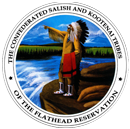![]() Principle 8e
Principle 8e
Tribal Elders Talk about the Change in Fire in the Northern Rockies
Across a territory of tens of millions of acres, and throughout a land tenure of many thousands of years, Salish and Pend d’Oreille people used fire to shape and care for their homeland in the northern Rockies. They more than doubled the frequency of natural fires, so much so that the plant and animal communities we have inherited today are in large measure the legacy of Indian burning. This was land management on a vast scale. Tribal people applied fire in various years, and at various times of year, and for various reasons, across the full range of the ecosystems of the Plateau, Northern Rockies, and high plains. Those fires profoundly shaped plant and animal communities.
It is difficult to imagine today. The suppression and exclusion of fire, and the tribal use of fire, has erased much of the fire-shaped landscape that once characterized much of western Montana. Beginning early in the twentieth century, fire policies of the U.S. government halted the practice of tribal burning and began suppressing and excluding natural fires.
Now climate change is creating a whole new set of challenges. By increasing the frequency and severity of wildfires it promises to bring even more dramatic change to our landscapes. On average, the western fire season is now 78 days longer each year compared with the period between 1970 and 1985, and has been accompanied by a four-fold increase in the number of large fires (>1000 acres) and a six-fold increase in the number of acres burned each year. Major factors in this increased frequency and severity include: significantly earlier snowmelt and hotter summer temperatures. Additionally, the longer fire season as well as the expanded vulnerable area of high-elevation forests (largely due to the earlier snowmelt) — are combining to produce the increase in frequency and severity of wildfires.
In the videos at right, you can learn from tribal elders about Salish and Pend d’Oreille burning in the northern Rockies and the impacts of a policy of fire exclusion. Watch and listen to what the elders have to say about the traditional use of fire, why the Tribes burned and where, the importance of native-set fires to hunting and plant harvesting, and the changes that have occurred in the last century.
After watching the videos, reflect on how a changing climate will affect tribal cultures that have practiced burning for thousands of years and whose cultural traditions and landscapes have been shaped to a very large degree on the use of fire.

Tony Incashola

Click on a question to hear Tony Incashola’s response
1. How was fire used by the Salish as part of their traditional way of life, and what happens culturally when fires are no longer allowed to burn?
1. How was fire used by the Salish as part of their traditional way of life, and what happens culturally when fires are no longer allowed to burn?
2. How was fire used in the places your family camped when you were growing up?
3. You have said your grandmother burned your family's camp area by the river to rid it of snakes and other pests. Is that right?
3. You have said your grandmother burned your family's camp area by the river to rid it of snakes and other pests. Is that right?
4. In traditional times, was there a leader in charge of fire?
5. What are some of the places where people used fire on the land?
6. What has been the consequence of excluding fire?
7. Are there place names in our aboriginal territory that refer to fire or the relationship between people and fire?
7. Are there place names in our aboriginal territory that refer to fire or the relationship between people and fire?
8. Do the place names used for millenia still describe those places?
9. How much have these places changed from the way they were in the times of our ancestors?
10. Can you talk specifically about how areas have changed because of the lack of fire? What have the elders said?
10. Can you talk specifically about how areas have changed because of the lack of fire? What have the elders said?
11. From a cultural standpoint, can you say why elders are concerned about the absence of fire?
12. How was fire used in warfare during traditional times?
13. How was fire used in hunting during traditional times?
14. In what other ways was fire used?
15. Was fire important socially?
16. Was fire or smoke used to communicate?
17. How was smoke or fire used for signalling?
18. Do you recall your grandparents or your parents talking about the Catholic conception of fire, and how did that affect the Tribal view?
18. Do you recall your grandparents or your parents talking about the Catholic conception of fire, and how did that affect the Tribal view?
19. What role do you think the elders should play in fire management and the reintroduction of fire to the land?
19. What role do you think the elders should play in fire management and the reintroduction of fire to the land?
20. What advice do you have for land managers as they think about and plan for the reintroduction of fire?
20. What advice do you have for land managers as they think about and plan for the reintroduction of fire?
21. Is fire important to the Tribe's spirituality?
22. Can you talk more about why fire is important to the spiritual life of Tribal people?
23. Why is fire preceived as an enemy by so many people?

Harriet Whitworth & Felicite McDonald

Click on a question to hear Harriet Whitworth’s and Felicite McDonald’s responses
1. In what ways did the People use fire?
2. Where were the fall hunting places that you know had been burned?
3. Can you think of other places in the mountains that were burned, and what changes have occurred after 100 years of being forbidden to burn?
3. Can you think of other places in the mountains that were burned, and what changes have occurred after 100 years of being forbidden to burn?
4. Can you give an example of how the burning was done?
5. Is the Bob Marshall more grown over now than when you were younger?
6. Did anyone put the fires out in the old days?
7. If they are going to burn again, what do you think would be the best way to do it?
8. So opening the woods and burning will help the deer and elk?
9. What do you remember about the animal herds from when you were younger?

Mike Durglo

Click on a question to hear Mike Durglo’s responses
1. How was fire used by the Salish as part of their traditional way of life?
2. What were some of the other uses of fire as a tool?
3. How did they know when to burn, and how was the knowledge passed on?
4. Can managers today use the same methods to reintroduce fire?
5. How have landscapes changed since you were young because of the absence of fire?
6. Can you talk more about the difference in attitudes toward fire among land managers today versus that of Indian people, especially in the past?
6. Can you talk more about the difference in attitudes toward fire among land managers today versus that of Indian people, especially in the past?
7. What kinds of plants and other things have disappeared because of the lack of fire?
8. Do you know of areas that were burned periodically when you were growing up?

Louie Adams

Click on a question to hear Louie Adam’s response
1. How was fire used by the Salish as part of their traditional way of life?
2. When you were growing up, what was the last time you heard of someone using fire in a traditional way?
2. When you were growing up, what was the last time you heard of someone using fire in a traditional way?
3. What was lost when they put an end to traditional burning?
4. You work in forestry. What kinds of changes have you seen in logs compared with when you were younger?
4. You work in forestry. What kinds of changes have you seen in logs compared with when you were younger?
5. In your forestry work, do you see evidence of past fires?
6. Why is fire so important?
7. Did the concept of fire change because of the teachings of the church and its association of fire with hell?
7. Did the concept of fire change because of the teachings of the church and its association of fire with hell?
8. Are there plants that are now gone because of fire exclusion?
9. Have you been to traditional camping areas that have become overgrown because of fire exclusion?
9. Have you been to traditional camping areas that have become overgrown because of fire exclusion?

Eneas Vanderburg

Click on a question to hear Eneas Vanderburg’s response
1. How was fire used by the Salish in traditional times and how does that contrast with today?
2. Why was the burning done?
3. What happens now when there is a lightning fire?
4. How was fire transported from place to place during traditional times so it could be used as a tool for burning different areas?
4. How was fire transported from place to place during traditional times so it could be used as a tool for burning different areas?
5. Do you have memories from your childhood about using fire as a tool?



